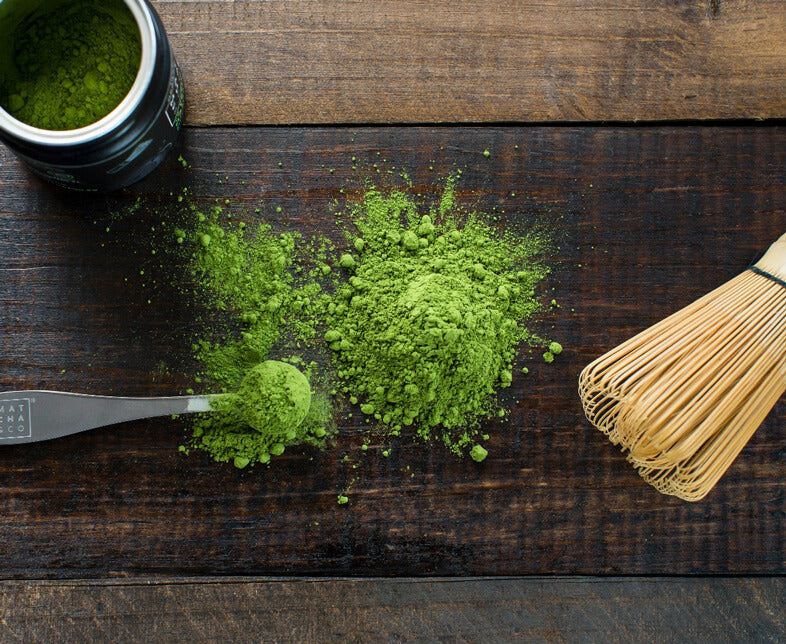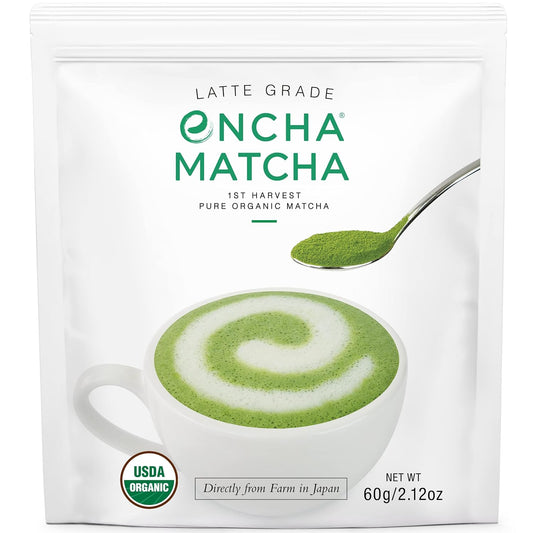Matcha and green tea are often used interchangeably but they're in fact not identical. How do they compare? Both have an earthy flavor and descend from the Camellia sinensis plant, but you will find the differences lie in their preparation, benefits and more.
Wondering about the matcha vs green tea choice? You’re not alone. Many are turning to these beverages for their health perks and unique flavors. But what sets them apart? Is matcha just a hype or does it truly eclipse traditional green tea? We’ll unpack the differences in taste, health benefits, and preparation methods to help you make an informed choice without the usual jargon or sales pitch.
Key Takeaways
-
Matcha and green tea come from the same plant, Camellia Sinensis, but differ in taste, color, and form — matcha is powdered and whisked, green tea comes in leaves or bags and is steeped.
-
Matcha’s shading before harvest amps up its chlorophyll and nutrient content, giving it a higher antioxidant level and wellness benefits like better focus, metabolism, and detoxification compared to green tea.
-
Matcha is not only a healthful drink but also a versatile culinary ingredient, adding its signature color and flavor to both sweet and savory dishes, unlike green tea, which is subtler and typically used in beverages and some desserts.
What is Green Tea?
Green tea comes from the leaves of the Camellia sinensis plant. The leaves are plucked, slightly withered, then immediately cooked to preserve the green quality and to prevent oxidization. This process is what gives green tea its lighter color compared to black tea and why it has a much higher concentration of chlorophyll, polyphenols, and antioxidants than other tea types.
Origins of Green Tea
Although originally used for medicinal purposes during the Han Dynasty (206-220), green tea didn't start being consumed for pleasure until China’s early Tang Dynasty (600-900). It wasn’t until the late 19th century that green tea made its way into European and more western cultures.
Benefits of Green Tea
Since green tea is loaded with antioxidants, it has many health benefits as a result, including:
- improved brain function
- protection against cancer
- lowered risk of heart disease
- protection of the brain from aging
- prevention of type 2 diabetes
What is Matcha?

Matcha is made from finely powdered dried green tea (tencha) leaves. The green tea plants used for matcha are shade-grown for three to four weeks before harvest with the stems and veins removed during processing. As a result, there are three different grades of matcha: ceremonial, latte, and culinary depending on their harvest and use.
Origins of Matcha
Despite Japan having such a stronghold on matcha, it actually first emerged during the Song Dynasty in China. The art of producing, preparing, and consuming matcha became a ritual performed by Zen Buddhists in China. In 1191, a Zen monk traveled to Japan and introduced matcha to the country. As matcha became less popular in China, the Japanese embraced it and it's now a key part of their culture, from Japanese tea ceremonies and the highest-quality matcha coming from the hills of Uji, Japan.
Benefits of Matcha
Since matcha uses the entire leaf, it has more nutritional compounds than green tea. With high levels of antioxidants and epigallocatechin-3-gallate (EGCG), matcha has even more health benefits, including:
- reduced oxidative stress
- reduced inflammation
- improved memory and cognitive functions
- minimized photoaging
- strengthened blood vessels in the heart
- promotion of metabolic health markers
- reduced factors of tumor growth in the gut
Matcha also has a complementary combo of l-theanine and caffeine which provides a boost of energy without the jitters or mid-day crash.
What is the difference between the two?
From preparation to processing and the benefits of consuming both, this chart below shows the key differences between matcha and green tea:
|
Matcha |
Green Tea |
| Processing |
Hand-selection of the best shade-grown leaves stone ground into a powder |
Cultivated under the sun and processed to stop fermentation |
| Color |
Vibrant green |
Dull green with a brownish tone |
| Taste |
Rich, velvety and sweet |
Light and fresh with grassy, earthy undertones |
| Preparation |
Whisked in hot water with a chasen |
Steeped in hot water for up to 3 minutes |
| Caffeine |
280 mg |
35 mg |
| Antioxidants |
134 mg |
63 mg |
| Tannins |
99 mg |
7 mg |
| Amino Acids |
45 mg |
3 mg |
Which one should you consume?
Whether you should drink matcha or green tea is purely based on personal preference. Both provide significant health benefits and it can come down to your sensitivity to caffeine or which flavor tastes better to you. If you are a matcha fan, then we highly recommend trying our Latte Grade as it's a great way to ease into the matcha space. If you're looking for a more premium matcha experience, then our Ceremonial Grade is the one for you. Our Culinary Grade is ideal if you'd like to use matcha when baking or cooking.
Why Encha Matcha tea
Encha Matcha is renowned for its reputation as the finest matcha powder available. Sourced from the lush tea fields of Japan, Encha Matcha stands out for its exceptional quality and meticulous processing. It's carefully crafted from shade-grown, young tea leaves, handpicked to ensure the utmost freshness and flavor. Encha's commitment to organic and sustainable farming practices further enhances its appeal. This vibrant green matcha is celebrated for its vibrant, grassy aroma, velvety texture, and balanced umami taste.

Brewing Battles: Preparing Matcha Tea vs Brewed Green Tea
With our leaves prepared, let’s delve into the process of brewing. How do we transform these leaves into a cup of delicious, health-boosting tea? Well, there’s an art to it, and as with everything else, matcha and green tea have their unique brewing methods.
Preparing matcha involves whisking the fine powder with hot water to form a frothy texture, making it a more interactive experience. Green tea, on the other hand, is all about the simplicity of steeping. The leaves gently unfurl in the hot water, imparting their subtle flavor to the brew.
We won’t limit our discussion to mere descriptions. Let’s delve into the detailed procedures of making a matcha latte and brewing green tea.
Whisking Up Wellness: The Matcha Latte
Making a matcha latte feels like whipping up a gourmet treat right at home. You start by whisking matcha powder with hot water, creating a smooth, frothy blend. Then comes the crowning glory - steamed milk, heated to a cozy 140-160°F, is poured into the matcha blend, creating a matcha latte that’s as comforting as a warm hug.
But why stop at the basics? The beauty of a matcha latte lies in its versatility. You can switch up the sweeteners, experiment with different milk types, or even add toppings for an extra flair. Whether it’s a drizzle of honey, a sprinkle of cinnamon, or a dollop of whipped cream, the possibilities are endless. And if you’re feeling fancy, why not sprinkle some extra matcha powder on top as a final touch?
The Simplicity of Steeping: Brewing Green Tea
Brewing green tea is all about simplicity and patience. It’s about taking the time to appreciate the subtle transformation of the leaves as they infuse their flavor into the hot water. Here’s how to brew green tea:
-
Add about 2 grams of tea leaves per 6 ounces of water into a teapot.
-
Pour hot water, ideally between 160°F to 180°F, over the leaves.
-
Let the leaves steep for 1 to 3 minutes.
Once the time’s up, you remove the leaves either by lifting the infuser or pouring the tea through a strainer. The result is a clear, calming brew that carries the grassy, earthy flavor of the leaves.
Want to enhance the flavor? Try pre-warming your teapot or cup before steeping the tea. And remember, whole tea leaves can be re-steeped 2 to 3 times, so don’t be too quick to throw them away.
Flavor Profiles: Earthy Umami vs Grassy Bitterness
We’ve talked about the visual differences, the brewing methods, and the health benefits. But what about the flavor? After all, taste is a fundamental part of the tea-drinking experience. Matcha, with its complex flavor profile, offers a mix of:
It’s like a symphony of flavors playing on your palate.
Green tea, on the other hand, offers a distinctly grassy yet earthy flavor when well-prepared using quality green tea leaves. It’s a more subtle, minimalist flavor that leaves a calming effect as it goes down. But as with any symphony, it’s not just about the individual notes but how they’re played.
Summary
That brings us to the end of our tea-infused journey. We’ve discovered the world of matcha and green tea, delved into their differences and similarities, explored their cultivation and processing methods, and uncovered their health benefits. We’ve also learned how to brew them to perfection, tasted their unique flavors, and even used them in a variety of recipes.
As we wrap up, remember that whether you’re sipping on a cup of ceremonial grade matcha or enjoying a green tea-infused dessert, you’re not just indulging in a delicious beverage or treat. You’re partaking in a tradition, a ceremony, a celebration of nature’s bountiful gifts. So, the next time you lift your tea cup, do so with a newfound appreciation for the journey it’s been through, from the leaf to your cup.
SHOP ENCHA MATCHA








